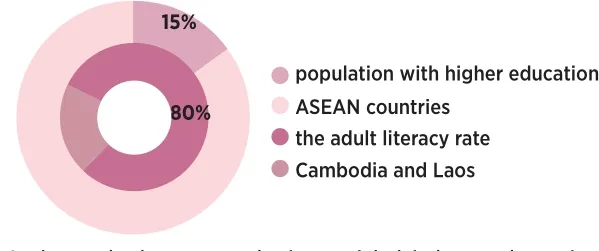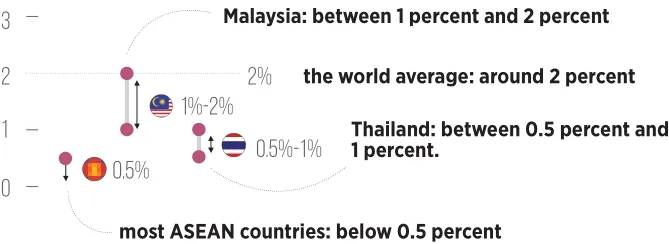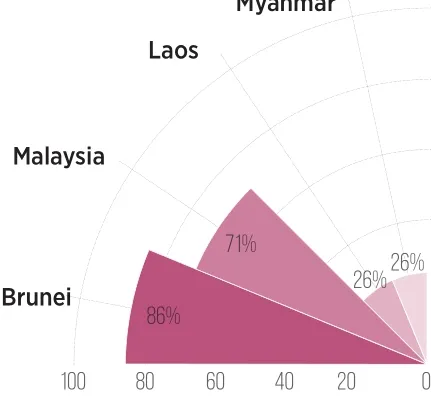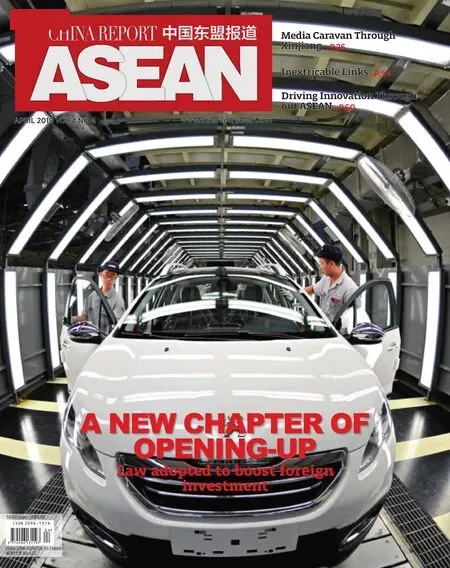DRIVING INNOVATION THROUGHOUT ASEAN
By Hao Nan
ASEAN's 2018 was themed resilience and innovation.Various initiatives and programs have proceeded within ASEAN and between ASEAN and its external partners.For example, internally, the ASEAN Smart Cities Network championed by Singapore, has been proved extremely popular. Externally, ASEAN-China Year of Innovation charted by ASEAN and Chinese leaders has been a resounding success.
However, can a region like ASEAN with great internal disparities really achieve innovation-driven prosperity?
Global Innovation Competition
Innovation is widely recognized as a central driving force for the global economy and national prosperity.Advanced countries leading innovation harvest the greatest returns from each single product manufactured in sweatshops in the developing world.In Switzerland, ranked the most innovative country in a report from the World Economic Forum, innovation tops its competitiveness and fuels its affluence despite a small population and scarce resources.
Capability to innovate and integration of innovation in the economy have been identified by most countries as a crucial issue and placed atop respective governments' agendas.Lagging countries are striving to catch up, while leading countries are making efforts to solidify their advantages.
The fierceness of innovation competition is vividly illustrated in China's Made in China 2025 strategy,a typical program aiming to help a developing country catch up in which innovation is perceived as the key to“national rejuvenation.” Likewise,the United States, in its Strategy for American Innovation, elaborated that“innovation is essential to winning the future through long-term growth and competitiveness.”
ASEAN Innovation Transformation and Challenges
As the world's sixth largest economy and the third largest market with a population of over 600 million,ASEAN is projected to have potential to incrementally add US$1 trillion to its GDP by 2025 through its vibrant digital economy.
Driven by the promise of the innovation dividend, ASEAN has been placing innovation at the center of policy agendas. This has been particularly highlighted in recent years. The 49th ASEAN Economic Ministers Meeting presented the overall thematic priority of 2017 as “inclusive,innovation-led growth” and specified ways to develop an innovation-driven economy. The proposal was eventually adopted by a leader-level ASEAN Declaration on Innovation at the Summit.
Furthermore, under Singapore's rotating chairmanship, 2018 was specially dedicated to “Resilience and Innovation,” working on harnessing opportunities and managing challenges from disruptive digital technologies,equipping ASEAN citizens with skills to build a future-ready ASEAN and boosting ASEAN capabilities to make ASEAN cities smarter. Indeed, ASEAN witnessed notable achievements resulting from these policy efforts.

On August 21, 2018, a 1.6-ton, 4-meter-diameter aperture optical mirror made of silicon carbide passed its final test after nine years of research and 18 months of production, making China one of the world leaders in the field.
Nevertheless, the challenges hindering ASEAN's innovation transformation are glaring, manifested by wide innovation gaps between ASEAN countries. Ranked by Global Innovation Index 2018, gaps are found between frontrunner Singapore at Number 5 and its nearest regional rival Malaysia at Number 35. Further down the list are Thailand (44), Vietnam (45),the Philippines (73) and Indonesia (85).The remaining three countries are still in initial conditions.
These gaps can be further broken down into disparities in knowledge,technology and entrepreneurship throughout ASEAN, with Singapore consistently singled out as a wellperforming exception.
· In knowledge, population with higher education in most ASEAN countries remains below 15 percent of the total, and the adult literacy rate in Cambodia and Laos have yet to surpass 80 percent. World top 300 universities can be found only in Singapore,Malaysia, Thailand and Indonesia. Only half of ASEAN countries (Singapore,Thailand, Malaysia, Vietnam and Indonesia) rank among top 100 in terms of the number of the applications of patents, trademarks and designs.
· In technology, proportions of research and development (R&D)expenditures compared to GDP in most ASEAN countries remain below 0.5 percent, far below the world average of around 2 percent.Malaysia is between 1 percent and 2 percent, while Thailand is between 0.5 percent and 1 percent. The same thing happened to R&D researchers per million people. Excluding Singapore with 6,658 researchers per 10,000 people, the next highest of the year was Malaysia, with 2,052 people. All others lagged far behind, below 1,000. Digital connectivity also varies. Brunei and Malaysia's internet penetration rates are 86 percent and 71 percent respectively,while only 26 percent of the population in Laos and Myanmar have access to the internet.
· In entrepreneurship, total early-stage entrepreneurial activity among adults in ASEAN countries remains negligible, so technological entrepreneurship is even rarer.
Given that ASEAN innovation transformation is collective rather than individual, such wide and multidimensional innovation disparities must bring huge challenges to any policy design, coordination and implementation at the regional scale,particularly under ASEAN's consensusbased decision-making process.
What's worse, ASEAN currently has a massive young population, 213 million youth (15-34 years), a large share of whom are not well-educated vocationally. In today's trend of industrial transformation and job automation, ASEAN countries are now under enormous pressure to create jobs to accommodate their populations.
Policy Solutions
The situation demands prudential policy efforts in the immediate, midand long-term to fill the innovation gaps between ASEAN countries.
1. Freer Flow of People
As an immediate response, a freer flow of people within ASEAN and between ASEAN and its innovative partners should be established,accompanied by education and vocational assistance focused on digital skills, technology and entrepreneurship. Innovation-literate people such as engineers, scientists and skilled technicians are the primary force accelerating innovation. This move should be carried out in immediate terms, particularly for labor-abundant but innovation-lagging ASEAN countries considering the impending automation of various jobs and the according decline in labor demand from aging but innovative economies.
By promoting flow of people, laborabundant ASEAN countries can ease employment pressure and receive dividends on domestic innovationoriented investment in knowledge,technology and entrepreneurship.Labor-receiving countries, particularly aging but innovative Singapore, Japan and South Korea, would also benefit from meeting their labor demands and sustaining their productivity.Furthermore, accompanying innovation-related vocational and educational spill-over effects would increase the ASEAN labor force's innovation literacy and lay a solid foundation for ASEAN's own innovation transformation.

Ranked by Global Innovation Index 2018, gaps are found between frontrunner Singapore at Number 5 and its nearest regional rival Malaysia at Number 35. Further down the list are Thailand (44), Vietnam(45), the Philippines (73) and Indonesia (85). The remaining three countries are still in initial conditions.

In knowledge, population with higher education in most ASEAN countries remains below 15 percent of the total, and the adult literacy rate in Cambodia and Laos have yet to surpass 80 percent.

World top 300 universities can be found only in Singapore, Malaysia, Thailand and Indonesia.

· In technology, proportions of research and development (R&D) expenditures compared to GDP in most ASEAN countries remains below 0.5 percent,far below the world average of around 2 percent.Malaysia is between 1 percent and 2 percent, while Thailand is between 0.5 percent and 1 percent.


Digital connectivity also varies. Brunei and Malaysia's internet penetration rates are 86 percent and 71 percent respectively, while only 26 percent of the population in Laos and Myanmar have access to the internet.
2. Market for Technology
In the mid-range term, the market for technology should receive greater focus in ASEAN's Foreign Direct Investment (FDI) negotiations. ASEAN is projected to maintain its high growth rate and rank as the fourth largest economy by 2030 as massive numbers of middle-class consumers emerge and infrastructure spending mushrooms. All these developments will bring tremendous opportunities for advanced economies and multinational companies, which are already fiercely competing for the market.
ASEAN countries, by means of the ASEAN institutions, can collectively negotiate with foreign investors to exchange entry to the market and favorable policies for benefits such as technology transfer, vocational and managerial training and other innovation-oriented corporate social responsibilities.
3. Innovation-friendly Institutions
In the long term, ASEAN should strive to establish innovationfriendly institutions domestically and internationally. Innovation-lagging countries should make structural reforms to prioritize innovationoriented policies and programs and accelerate administrative pace to stay abreast of global trends.
This can start with small-scale experimental innovation zones with favorable policies to better and more quickly accommodate innovative entrepreneurships, thereby attracting a spill-over effect throughout the rest of the region.

